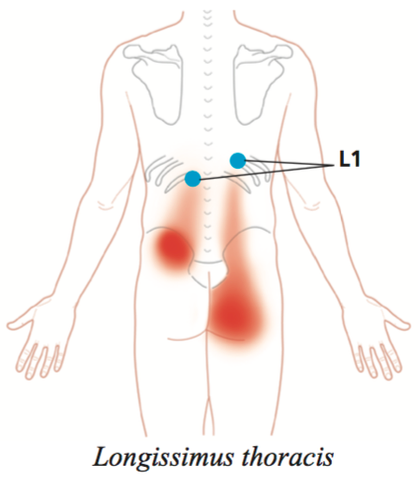Taping for Lower Back Pain
Posted by Stuart Hinds on
Stuart Hinds demonstrates the taping technique for erector spinae trigger points
Erector Spinae Muscles
- Iliocostalis. Iliocostalis cervicis. Iliocostalis thoracis. Iliocostalis lumborum.
- Longissimus. Longissimus capitis. Longissimus cervicis. Longissimus thoracis.
- Spinalis. Spinalis capitis. Spinalis cervicis. Spinalis thoracis.
The erector spinae, also called the sacrospinalis, comprises of three sets of muscles organized in parallel columns. From lateral to medial, they are: iliocostalis, longissimus, and spinalis.

Erector Spinae Trigger Points
Origin
Slips of muscle arising from the sacrum. Iliac crest. Spinous and transverse processes of vertebrae. Ribs.
Insertion
Ribs. Transverse and spinous processes of vertebrae. Occipital bone.
Action
Extends and laterally exes vertebral column (i.e. bending backward
and sideways). Helps maintain correct curvature of spine in the erect and sitting positions. Steadies the vertebral column on the pelvis during walking.
Antagonist: rectus abdominis.
Nerve
Dorsal rami of cervical, thoracic, and lumbar spinal nerves.
Basic Functional Movement
Keeps back straight (with correct curvatures), therefore maintains posture.



Referred Pain
Thoracic spine—iliocostalis: medially toward the spine, and anteriorly toward the abdomen.
Lumbar spine—iliocostalis: mid buttock.
Thoracic spine—iliocostalis: buttock and sacroiliac area.
Indications
Low back pain (especially after lifting), reduced range of motion in the spine, low back pain (from sitting/standing/climbing stairs), low grade back ache worsening toward the end of the day.
Common Causes
Poor posture, playing musical instruments, lying on front with head propped up, poor glasses, upper crossed pattern, kyphosis, scoliosis, wear and tear, cold drafts/ air conditioning, vertebral alignment issues, certain sports (e.g. archery), tight shirt/tie, depression.
Differential Diagnosis
Angina. Visceral pain. Radiculopathy. Ligamentous, discogenic, sacroiliac. Piriformis. Pathological: aortic aneurysm. Visceral pathology. Space-occupying lesion. Pelvic in ammatory disease.
Connections
Pectoralis major.
Common Techniques
| Spray and Stretch | YES |
| Dry Needling | YES |
| Deep Stroking Massage | YES |
| Compression | YES |
| Muscle Energy | YES |
| Positional Release | YES |
| Wet Needling | YES |
| Taping | YES |
Related Courses

Taping for Trigger Points NAT Foundation Course
Trigger Point Foundation Course
Trigger Point Theory Master Course Collection
About the author
Stuart Hinds is one of Australia’s leading soft tissue therapists, with over 27 years of experience as a practitioner, working with elite sports athletes, supporting Olympic teams, educating and mentoring others as well as running a highly successful clinic in Geelong.
Stuart has a strong following of practitioners across Australia and globally who tap into his expertise as a soft-tissue specialist. He delivers a range of highly sought after seminars across Australia, supported by online videos, webinars and one-on-one mentoring to help support his colleagues to build successful businesses.
In 2016, Stuart was awarded a lifetime membership to Massage & Myotherapy Australia for his significant support and contribution to the industry.
This trigger point therapy blog is intended to be used for information purposes only and is not intended to be used for medical diagnosis or treatment or to substitute for a medical diagnosis and/or treatment rendered or prescribed by a physician or competent healthcare professional. This information is designed as educational material, but should not be taken as a recommendation for treatment of any particular person or patient. Always consult your physician if you think you need treatment or if you feel unwell.
